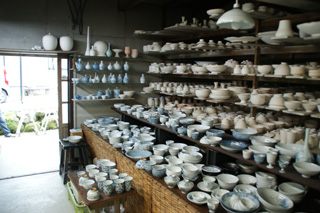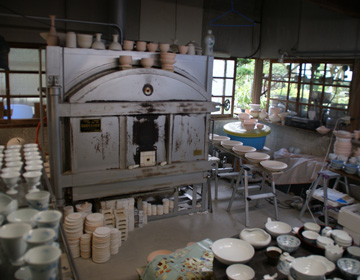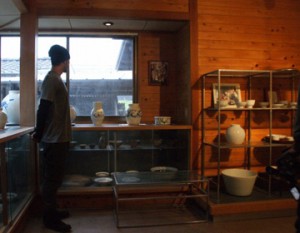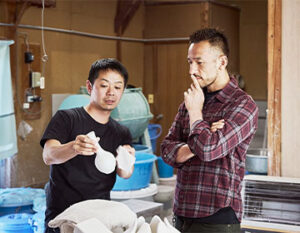Porcelain from about 400 years ago
About 400 years ago, tiered, connected chamber climbing kilns were built in three areas of Muraki, Hasami-cho, namely Hatanohara, Furusaraya, Yamanita, and pottery making began. They produced a large amount of tableware for mass market with the huge connected chamber climbing kilns (in the late Edo period, the production of blue and white porcelain in Hasami was the largest in Japan), ”Hasami-yaki” spread all over the country because it was sold at affordable prices.
The characteristic of ”Hasami-yaki” is the beautiful translucent white porcelain, and the delicate and profound ”blue and white” patterns painted with a pigment called ”gosu” (indigo). The elegance of the open work carving and the crosshatch pattern is unique to Hasami-yaki, yet it was born as tableware for commoners, and has changed and been refined according to the lives of people of that era during the course of its long history.

Visiting the workshop
”Kurawanka bowl” which is said to be the representative product of Hasami-yaki, has simple drawings in indigo. It is said to have been named after the merchants’ words, ”mochi kurawanka, sake kurawanka”, meaning ”don’t you want rice cakes, don’t you want sake”. This phrase was used by merchants in the Edo period, when they approached the ships along the Yodo River at Settsu on small boats, selling their goods. With a slightly rough surface similar to earthenware, simple patterns and affordable prices, ”Kurawana bowl” gained popularity among the commoners. Not only did it largely effect the common sense of the time that porcelain was an luxury item, but it was also loved for its rustic yet skillful elegance, and was imitated in other locations that produced ceramics.
Nakata visited the workshop of Heisabu Nakamura. He is skilled at shaping, especially with a potter’s wheel, and has spent 60 years to polish his skills with training and practice. His extraordinary pottery technique was widely acknowledged, earning hi a commendation from the Minister of Economy, Trade and Industry, and designation as Prefectural Intangible Cultural Property. He remains to be the leader of wheel shaping in Hizen, even to this day.








